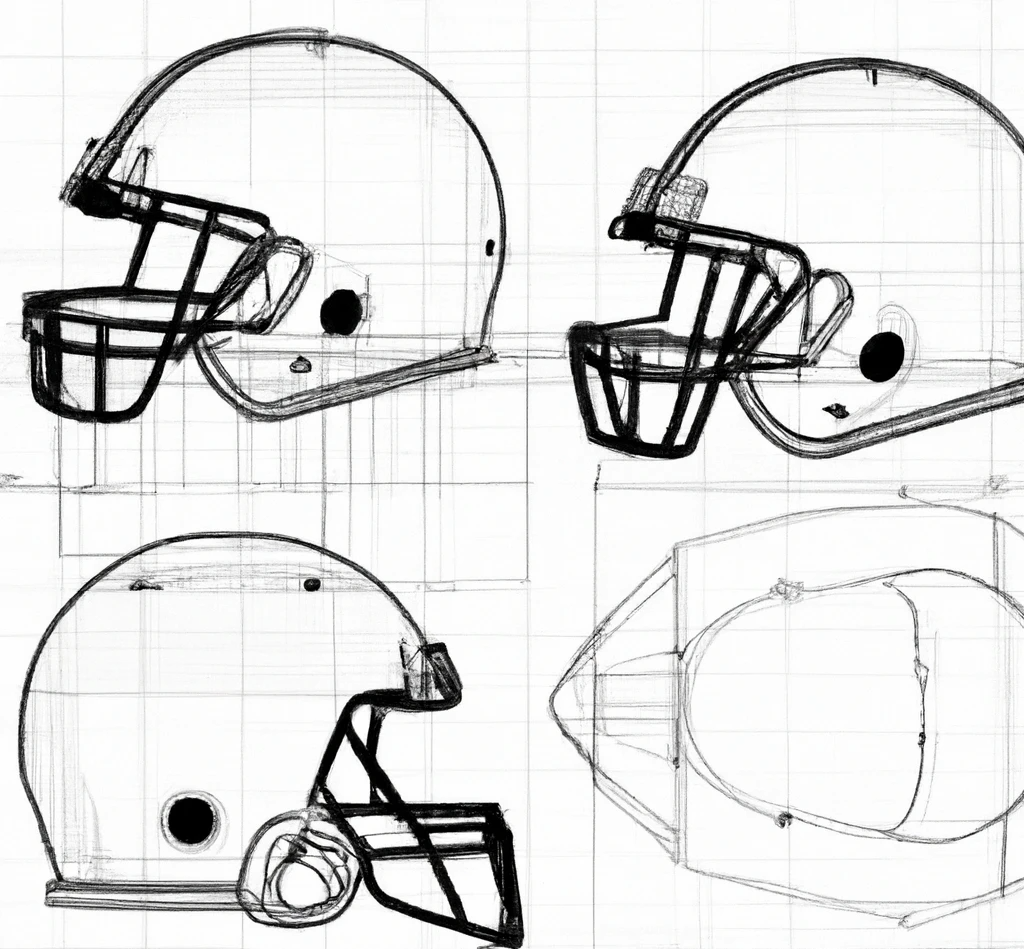Are you aware of the monumental strides made in football helmet technology that have reshaped the landscape of player safety in the sport?
The evolution of helmets from simple leather caps to the sophisticated designs of today has significantly enhanced impact absorption and reduced the risk of traumatic brain injuries on the field.
By integrating energy-absorbing liners, cutting-edge materials, and innovative features, modern helmets prioritize player safety like never before.
Stay tuned to discover how these advancements are paving the way for a safer future in football, promising a game where athletes can perform at their best with minimized risk.
Position-Specific Helmet Innovation
Position-specific helmet innovation has revolutionized football safety by tailoring protection to the unique demands of different player positions. These specialized helmets, like the VICIS ZERO2 MATRIX QB, are designed to cater to the specific needs of quarterbacks, linemen, and other players on the field.
For instance, the quarterback-specific helmet helps mitigate impacts when helmets hit the ground, reducing the risk of head injuries. By introducing position-specific helmets, the NFL has raised the bar for player safety, ensuring that each player receives optimized protection based on their role in the game.
The rigorous testing and specialized design of these helmets have shown promising results, with the VICIS ZERO2 MATRIX QB outperforming popular helmets by 7% in specialized testing. As football continues to evolve, these innovative helmets play a crucial role in safeguarding players and minimizing the risk of concussions and other head injuries on the field.
Liquid Shock Absorber Technology
Liquid Shock Absorber Technology represents a groundbreaking advancement in football helmet safety, developed by Savior Brain and Stanford University. This innovative technology aims to reduce impact force by a third compared to traditional helmets, significantly lowering the risk of concussions.
Through the integration of liquid shock absorbers, research and testing have demonstrated the effectiveness of this technology in protecting players from traumatic brain injuries. By absorbing and dissipating impact forces more efficiently, these helmets mark a significant step forward in enhancing player safety on the field.
With ongoing advancements in helmet design and materials, the incorporation of liquid shock absorbers showcases a promising direction for reducing head injuries in football. Embracing this cutting-edge technology not only prioritizes player safety but also underscores the continuous efforts to make football a safer sport for athletes at all levels.
NFL Collaboration for Helmet Safety
Collaborating closely with biomechanical engineers and medical experts, the NFL has made significant strides in enhancing helmet safety to reduce the incidence of concussions among players. Through rigorous testing and research, the NFL has achieved a 25% reduction in concussions over five seasons. By simulating on-field conditions, helmets are developed to lessen impact severity, prioritizing player safety.
Position-specific helmets for quarterbacks and linemen have excelled in NFL-NFLPA rankings, showcasing the commitment to tailored protection. This partnership underscores the league’s dedication to preventing concussions and prioritizing player well-being on the field.
As the NFL continues to lead in helmet safety innovation, collaborations with experts in the field highlight the importance of ongoing advancements. The focus on player safety remains paramount, with a collective effort to advance technology for a safer football experience.
LSU’s Helmet Prototype Development
In the realm of football helmet innovation, LSU Mechanical Engineering researchers are actively developing a groundbreaking prototype for enhanced player safety. This prototype aims to surpass current market helmets in protecting against head impacts.
Led by Assistant Professors Hunter Gilbert and Genevieve Palardy, the team is exploring advanced materials and designs, including 3D-printed structures. The goal is to have the prototype ready for testing by summer 2024 to further enhance player safety.
LSU Mechanical Engineering researchers leading the development.
Prototype aiming to surpass current market helmets in head impact protection.
Exploration of advanced materials and designs, including 3D-printed structures.
Led by Assistant Professors Hunter Gilbert and Genevieve Palardy.
Targeting testing readiness by summer 2024 to enhance player safety.
Overall Safety Advancements in Helmets
The comprehensive effort to enhance player safety through technological innovation in football helmets marks a significant leap forward in reducing head injuries in the sport. Advancements in overall safety features have been pivotal in enhancing head protection on the field.
Position-specific helmets tailored to different player roles, like linemen and quarterbacks, provide customized protection based on unique demands. Liquid shock absorber technology, developed by Savior Brain and Stanford University, reduces impact forces significantly, lowering the risk of concussions.
Collaboration between the NFL, biomechanical engineers, and medical experts has led to a 25% reduction in concussions over five seasons, showcasing the commitment to player safety. LSU’s ongoing development of an advanced helmet prototype using cutting-edge materials and designs further underscores the dedication to elevating player safety standards.
These collective advancements underscore a continued commitment to making football a safer sport for all its participants.
Biomechanical Engineering in Helmet Design
Enhancing player safety through technological innovation has paved the way for a deeper exploration of Biomechanical Engineering in Helmet Design.
Biomechanical engineering focuses on understanding how forces affect the human body, leading to innovative helmet designs that mitigate head injuries effectively.
Here are some key advancements in this field:
Customized Impact Absorption
Helmets tailored to specific player positions offer enhanced protection by addressing position-specific impact risks.
Energy-Dissipating Materials
Liquid shock absorber technology significantly reduces impact forces, lowering the risk of concussions.
Industry Collaboration
Partnerships between the NFL and biomechanical engineers have led to substantial reductions in concussions through rigorous testing and innovation.
Cutting-Edge Prototypes
Ongoing research, like LSU’s new helmet prototype, explores advanced materials and designs to surpass current safety standards.
Overall Safety Advancements
The collective effort in biomechanical engineering marks a significant step forward in enhancing player safety through tailored protection, advanced materials, and collaborative strategies.
Future Trends in Helmet Technology
With advancements in helmet technology paving the way for enhanced player safety, the future holds exciting prospects for further innovations in head protection.
Position-specific helmets tailored to different player positions, such as those introduced for offensive and defensive linemen, are revolutionizing the industry. These specialized helmets aim to provide tailored protection based on unique player demands.
One example is the quarterback-specific design that mitigates impacts when helmets hit the ground. Liquid shock absorber technology, developed by Savior Brain and Stanford University, is another groundbreaking advancement.
These helmets reduce impact force by a third compared to traditional ones, significantly lowering the risk of concussions.
Collaborations between the NFL and biomechanical engineers have led to a 25% reduction in concussions over five seasons, highlighting the importance of rigorous testing.
LSU’s helmet prototype development, incorporating advanced materials and 3D-printed structures, further underscores the commitment to player safety. Overall, these future trends in helmet technology mark a significant leap forward in reducing head injuries in football.
Player-Specific Helmet Advancements
Amidst the evolving landscape of football helmet technology, tailored advancements for specific players are revolutionizing player safety on the field.
These player-specific helmet advancements cater to the unique needs and risks faced by different positions, enhancing protection and reducing the likelihood of head injuries:
Position-Specific Helmets
NFL has introduced helmets designed for specific player positions, such as linemen and quarterbacks, providing tailored protection based on the demands of their roles.
Liquid Shock Absorber Technology
Helmets integrating liquid shock absorbers have been developed to significantly reduce impact forces and lower the risk of concussions compared to traditional helmets.
NFL Partnership and Innovation
Collaborating with experts, the NFL has successfully reduced concussions by 25% over five seasons, with position-specific helmets ranking highly for player safety.
LSU Helmet Prototype Development
LSU researchers are working on a prototype helmet using advanced materials and designs, aiming to surpass current market offerings in head impact protection.
Overall Football Helmet Safety Advancements
A comprehensive effort involving cutting-edge materials and design strategies marks a significant leap forward in reducing head injuries, showcasing a commitment to ongoing player safety improvements.
Conclusion
You’ve seen how advancements in football helmet technology have transformed player safety on the field. From position-specific designs to liquid shock absorbers, the collaboration between the NFL and universities like LSU is pushing the boundaries of innovation.
With a focus on biomechanical engineering and player-specific enhancements, the future of helmet technology looks promising. Stay tuned for more groundbreaking developments that will continue to prioritize player safety in the world of football.


